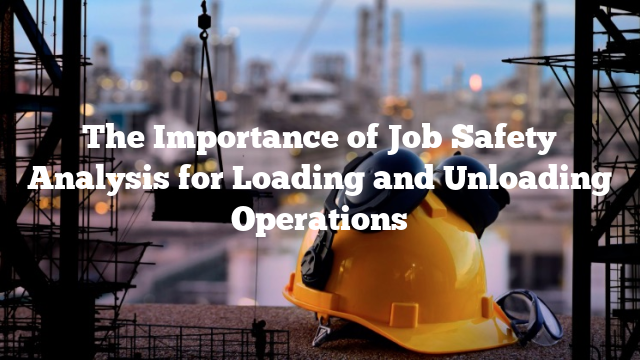Job Safety Analysis for Loading and Unloading: Keeping Workers Safe
As businesses continue to grow, loading and unloading activities have become more common. While these activities are necessary for the efficient transfer of goods, they pose a significant risk to workers. According to the Bureau of Labor Statistics, loading and unloading activities account for a significant number of workplace injuries and fatalities in the United States. As such, it is essential to conduct a job safety analysis for loading and unloading to identify potential hazards and take steps to mitigate them.
In this blog post, we will discuss what job safety analysis for loading and unloading entails, why it is crucial, and provide some tips and tutorials on how to conduct a thorough analysis. We will also provide a listicle of facts and figures related to workplace injuries in the loading and unloading industry and answer some frequently asked questions about job safety analysis for loading and unloading.
What is Job Safety Analysis for Loading and Unloading?
Job Safety Analysis (JSA) is a technique used to identify potential hazards associated with specific job tasks. It involves breaking down a job into its component steps and analyzing each step to determine the hazards associated with it. The goal of a JSA is to develop procedures to eliminate or mitigate these hazards and ensure the safety of workers.
In the context of loading and unloading, a JSA involves analyzing the various tasks involved in loading and unloading goods and identifying the hazards associated with each task. This analysis can include everything from assessing the weight of the load and the equipment used to move it to the surrounding environment’s layout and conditions.
Why is Job Safety Analysis for Loading and Unloading Crucial?
Loading and unloading activities are among the most dangerous tasks in the logistics industry. The risk of injury or death is high due to the size and weight of the loads being moved, the use of heavy equipment, and the fast-paced nature of the work. By conducting a job safety analysis for loading and unloading, workers and employers can identify potential hazards and take steps to mitigate them. This can reduce the risk of workplace injuries and fatalities and improve the overall safety of the workplace.
Facts and Figures Related to Workplace Injuries in the Loading and Unloading Industry
– According to the Bureau of Labor Statistics, there were 42 fatal injuries in the loading and unloading industry in 2019.
– Of these 42 fatalities, 30 were due to transportation incidents, 6 were due to contact with objects and equipment, and 6 were due to falls.
– Workers in the loading and unloading industry are at high risk of musculoskeletal disorders due to the repetitive nature of the work and the heavy lifting involved.
– According to the Occupational Safety and Health Administration (OSHA), employers in the loading and unloading industry must provide training to workers on the hazards associated with the work and the proper use of equipment.
Tutorial of Job Safety Analysis for Loading and Unloading
Step 1: Break down the job into its component tasks.
Step 2: Identify the hazards associated with each task.
Step 3: Assess the risk associated with each hazard.
Step 4: Develop procedures to eliminate or mitigate the hazards.
Step 5: Implement the procedures and monitor their effectiveness.
Tips of Job Safety Analysis for Loading and Unloading
1. Involve workers in the analysis process.
2. Use a checklist to ensure that all tasks and hazards are identified.
3. Consider the surrounding environment, including lighting, noise, and weather conditions.
4. Train workers on the procedures developed as a result of the analysis.
Question and Answer of Job Safety Analysis for Loading and Unloading
Q: Who should conduct a job safety analysis for loading and unloading?
A: Employers and workers in the loading and unloading industry should collaborate to conduct a job safety analysis.
Q: Do employers have a legal obligation to conduct a job safety analysis for loading and unloading?
A: Yes, employers have a legal obligation under OSHA regulations to provide a safe workplace for their employees, which includes conducting a job safety analysis.
Q: What are the benefits of conducting a job safety analysis for loading and unloading?
A: Conducting a job safety analysis can help prevent workplace injuries and fatalities, reduce workers’ compensation costs, and improve overall workplace safety.
Q: How often should a job safety analysis for loading and unloading be conducted?
A: A job safety analysis should be conducted whenever there is a change in job tasks or conditions that could affect worker safety.
Conclusion of Job Safety Analysis for Loading and Unloading
In conclusion, loading and unloading activities pose significant risks to workers, and it is essential to conduct a job safety analysis to identify potential hazards and take steps to mitigate them. By involving workers in the analysis process and using checklists and proper training, employers can ensure a safe workplace and prevent workplace injuries and fatalities. Remember, safety should always be a top priority in the loading and unloading industry.
Recommendations:
- Health And Safety Topics Occupational health safety is the industry leading news magazine enewsletter and website for occupational health and safety professionals focusing on problem solving solutions latest news. Health safety committee member health…
- The Best 20+ Safety Signs Workplace For Your Safety… When must safety signs workplace be used. Our most popular example of safety signs for the workplace are available with english spanish or multilingual language options. Workplace Safety Signs Choose…
- Health And Safety Inspection Report Template Use for office health and safety audits. Add a badge to your website or intranet so your workers can quickly find answers to their health and safety questions. Safety Report…
- The Importance of Job Safety Analysis in Scaffolding Work Job Safety Analysis for Scaffolding Work: Ensuring Safety at Heights Scaffolding work is an essential part of construction and maintenance jobs that involve working at heights. It provides a safe…
- 15 Essential Safety Rules for Your Computer Lab \" and summarize the main points of the article, while also including a call-to-action for the reader to implement these safety rules in their own computer labs. Tutorial of list…
- United Safety Logo Communication is the key. Disability confident the disability confident scheme supports employers to make the most of the talents disabled people can bring to your workplace. File United Safety Logo…
- Workplace Safety Safety Topics Holding employee meetings to discuss relevant workplace safety topics is an important aspect of providing workers with a safe and healthy work environment. Find thousands of safety management resources by…
- Uv Light Safety Glasses Set of orange lens safety glasses for red blue laser uv light protection see more like this 10x newest safety protective eye goggles glasses eyewear for leduv curing light brand…
- Keeping Safe Images If you're looking for keeping safe images pictures information linked to the keeping safe images interest, you have pay a visit to the right blog. Our website frequently provides you…
- Understanding the Importance of Safety Precautions Safety Precaution Meaning: Understanding the Importance of Safety Measures in Our Daily Lives Safety is of utmost importance in every aspect of our lives, whether at home, work, or on…
- Workplace Safety Topics For Meetings Fresh ideas for tailgate meetings or safety moments at work. Health safety committee member health care provider. Coping With Stress At Home Bheema Office Safety Safety Posters If not choose…
- 10 Tips for Preventing Slips, Trips and Falls in the… Workplace Slips Trips and Falls Prevention: Essential Tips and Facts Accidents in the workplace can happen anytime, anywhere. One of the most common types of these accidents is slips, trips,…
- The Top 10 Safety Hazard In Kitchen and How To… Each group is allocated one of the food safety hazard in kitchen and must come up with a short drama that shows. We use our kitchens every day to prepare…
- 10 Tips for Preventing Workplace Slips, Trips, and Falls Introduction: Slips, trips, and falls are the most common cause of workplace injuries, leading to a significant number of fatalities and injuries each year. These accidents can happen in any…
- Hazard And Risk Images If you're searching for hazard and risk images images information linked to the hazard and risk images keyword, you have come to the ideal site. Our site frequently gives you…
- 10 Essential Tips to Prevent Workplace Slips, Trips,… Introduction: Slips, trips, and falls are common hazards in the workplace that can lead to serious injuries or even fatalities. Whether it's a slippery floor, cluttered walkways, or poor lighting,…
- Health Safety Inspection Workplace Inspection… For example you can focus on the most common tasks your workers perform or on. 177 free health and safety checklists. Pshsa Sample Workplace Inspection Checklist Name of health and…
- Free Workplace Health And Safety Posters See more ideas about office safety safety posters and workplace safety. Download public administration and safety industry poster a4 portrait as a pdf 653 mb download public administration and safety…
- JSA vs SWMS: Understanding the Key Differences Difference Between JSA and SWMS: A Comprehensive Guide Are you familiar with the terms JSA and SWMS? These are two important safety documents that are often used in workplaces to…
- Safety Quotes For The Workplace Display them around your workplace or add them to internal newsletters. Apr 25 2019 explore sotorioss board safety quotes for workplace on pinterest. Safety Quotes For The Workplace Safety In…
- The Importance of Workplace Slips, Trips, and Falls… Introduction: Workplace slips trips and falls prevention is a crucial topic to consider for every company and organization. According to the National Safety Council, slips, trips, and falls are the…
- Health And Safety Inspection Form Safety inspections are essential to ensuring and effective safety program. More about download the free osh answers app. Workplace Health And Safety Inspection Forms Survey Templates And Alternatively they may…
- United Rentals Trench Safety Logo Call national trench safety. Trench and excavation operations are among the most dangerous jobs in the construction industry according to united rentals which is participating in trench safety educational events…
- Inside a Comprehensive Health and Safety Inspection… \\\". Introduction: Health and safety inspection report example is a crucial document that highlights the results of a thorough inspection of a workplace or building. This report ensures that the…
- Take 5 Safety Poster Large colorful and motivational banners and posters promote safety job quality accident prevention teamwork and much more. Safety briefs a set of 12 11x145 posters that take advantage of the…
- 5 Minute Safety Talks: Keeping Your Workplace Safe… \" and summarize the main points of the article. Introduction: According to the Occupational Safety and Health Administration (OSHA), nearly 4,700 workers died on the job in 2019. This number…
- Discover Job Hazard Analysis Examples to Improve… Job Hazard Analysis Examples. Every workplace has its own set of safety standards and procedures. But it can be difficult to know which safety protocols are most effective, and which…
- 5 Essential Tips for Preventing Slips, Trips and… Introduction: Did you know that slips, trips, and falls are the leading cause of workplace accidents? In fact, according to the National Safety Council, over 9 million slip, trip, and…
- Workplace Fire Safety Poster Here are alscos useful safety posters with messages that motivate and encourage safety. Why workplace safety is important. Poster Hot Tips About Fire Safety Eng Since the law also requires…
- Safety Quotes Workplace Display them around your workplace or add them to internal newsletters. The use of silly and meaningless safety slogans matters it creates a distraction and delusion that safety and risk…
Advertisement
Scroll to Continue With Content




